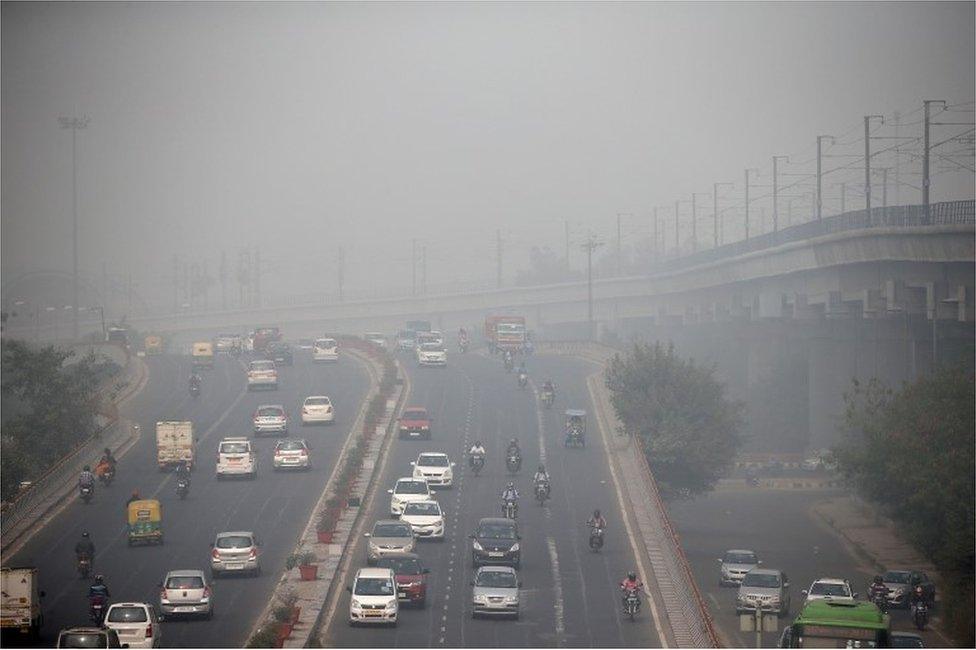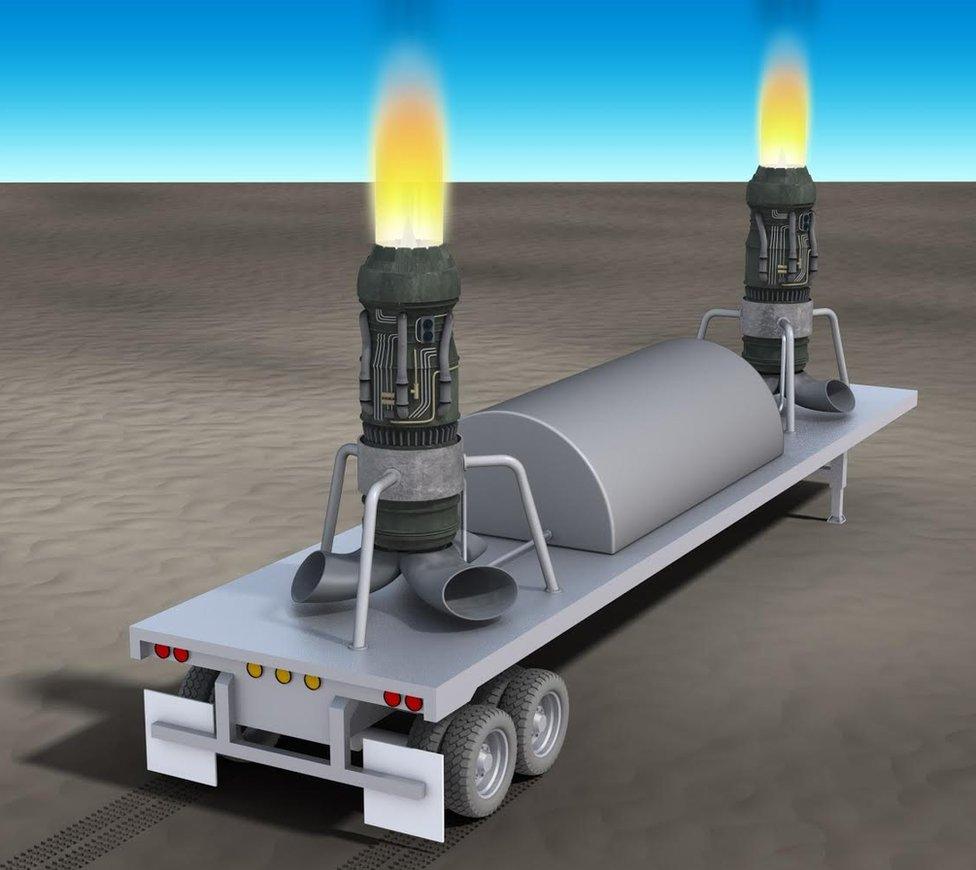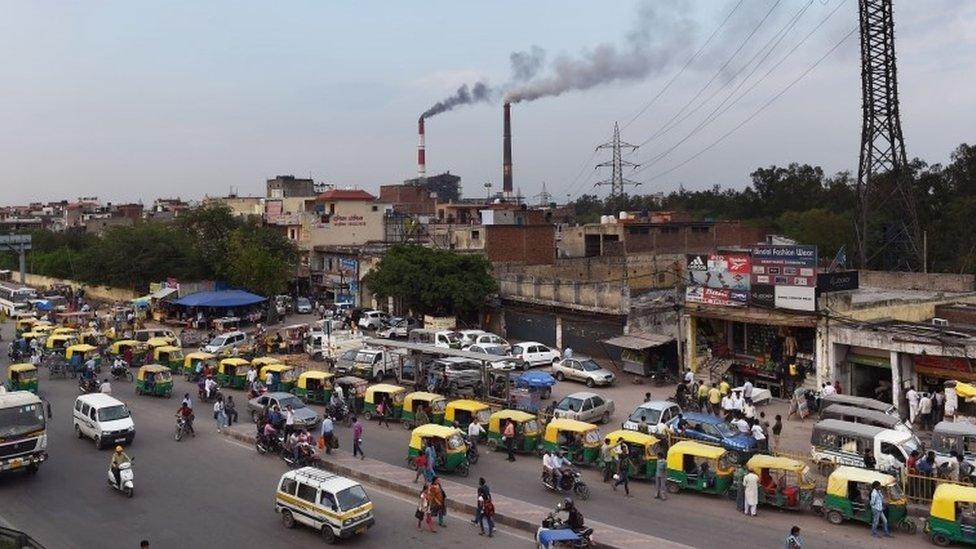Can jet engines clean up Delhi's foul air?
- Published

Delhi is one of the most polluted cities in the world
Sometime next year, if all goes well, a retired jet engine will be mounted on a flatbed trailer and taken to a coal-fired power plant in Delhi.
With the exhaust nozzle pointed at the sky, the engine will be placed near the smokestack and turned on.
As the engine roars to life, it will generate a nozzle speed of 400 metres per second (1,440km/h; 900mph), which is more or less the speed of sound.
The exhaust will create powerful updrafts that will, to put it simply, blast the emissions from the plant to higher altitudes, above a meteorological phenomenon called temperature inversion, where a layer of cold air is held in place by a warmer "lid" trapping smog.
The jet exhaust will act as a "virtual chimney", drawing in and transporting the smog, which makes Delhi's air some of the most toxic in the world. A single jet engine can deal with emissions from a 1,000 megawatt power plant.
So can jet engines help clean up Delhi's foul air? A team of researchers from the US, India and Singapore believes so.
"This could lead to a successful implementation of a new technology for smog mitigation all over the world," the lead researcher, Moshe Alamaro, an aeronautical engineer and atmospheric scientist at the Massachusetts Institute of Technology, tells me.
"The programme could use retired and commercial engines and has the possibility of adding value to numerous retired propulsion systems available."
Delhi is an ideal candidate for this experiment. The widespread use of festival fireworks, the burning of rubbish by the city's poor, plus farm waste from around the city, vehicular emissions and construction dust, all contribute to the city's thick "pea-soup" fogs.

The jet engines will be mounted on a flatbed trailer
Things get worse in winter: last month, schools were shut, construction and demolition work suspended, people wore face masks and were asked to work from home.
The move came after levels of PM2.5 - tiny particles that can affect the lungs - soared to over 90 times the level considered safe by the World Health Organization and 15 times the federal government's norms.
Carrying out the jet engine experiment outside a coal-fired electricity plant makes sense as coal accounts for more than 60% of India's power generation. In two years, the country could surpass China as the biggest importer of thermal coal.
Coal-fired energy may be linked to more than 100,000 premature deaths and millions of cases of asthma and respiratory ailments. Also, emissions from a 1,000-megawatt coal-fired plant are equivalent to emissions from roughly 500,000 cars.
Scientists say that jet engines were used in the Soviet Union 45 years ago to enhance rainfall.
"They achieved some success," says Dr Alamaro. "As far as I know nobody tried using jet engines for smog mitigation."
Noise concerns
Farmers have also rented helicopters to hover over their fields to "agitate and disrupt the inversions" to protect their crops.
Next month, Dr Alamaro will join some of India's top scientists and collaborators from government agencies at a workshop to plan the experiment.
There are concerns: noise from the jet engine, for example.
"In the beginning," he says, "the jet engine will be tested in remote location and not necessarily near a power plant, to observe the jet properties and for optimisation."
The scientists say that fears about emissions from jet engines fouling the air are unfounded as their emissions "are much cleaner than that of the power plant per unit of power".
There are reportedly offers of retired jet engines from air forces in India and the US for the experiment.
Scientists are talking to Tata Group, a private power producer, to use one of their plants for a site for the experiment.
Before the test, meteorological data on the area, along with information on frequency of smog will be essential. Drones will be used before and after the experiment.

Coal-powered thermal power plants meet most of India's energy needs
Critics of the planned experiment doubt whether the jet exhausts will be powerful enough to create a virtual chimney and blow out the smog, and question whether expensive jet engines can be used on a large scale to control air pollution in a vast city such as Delhi.
But Dr Alamaro is optimistic.
"Each new technology should start with the least resistant path for success," he says.
"The concentration of emission from coal is very high near the power plant.
"So a jet engine that elevates this emission is more effective near the power plant than somewhere else in the city that is plagued by smog.
"That said, we also plan to try to elevate the less concentrated smog in and around the city by jet systems.
"For example, the jet system can be placed near highways where vehicle emission is high, so the jet is more effective than somewhere else in the city."
If successful, Dr Alamaro says, this method can be used "anywhere and anytime, away from a power plant and during normal atmospheric conditions" to control air pollution.
Fairly soon, we may know if jet engines can really help to clean Delhi's foul air.